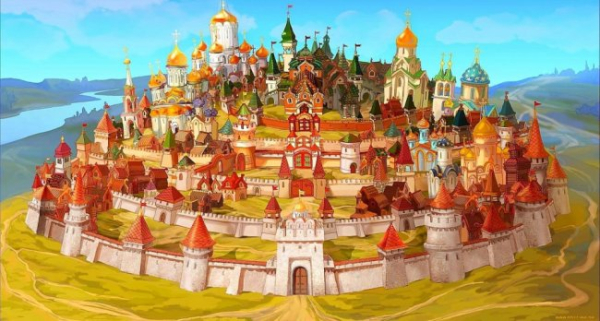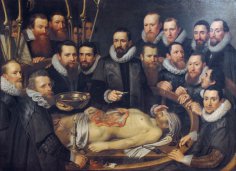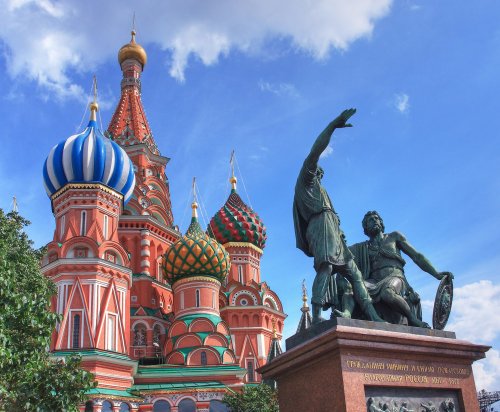
Slavic myths and fairy tales featured real geographic locations: bogatyrs guarded the outposts of large cities, heroes sailed down the Mother Volga, and princes reigned over their lands—Novgorod, Suzdal, and Moscow. But for rejuvenating apples, characters in fairy tales and legends traveled to the faraway kingdom, and to find Koschei's death, to a mysterious island. Read on to learn how to swim across the Smorodina River, find the nearest witches' sabbath, and observe the townspeople who sleep for five months a year.
Lukomorye
In some legends, the Slavs called Lukomorye a sacred place at the very edge of the earth. A world tree grew there, which could be used to reach other worlds: its branches reached the sky, and its roots reached the underworld of the dead. The oak was most often considered such a tree. In the poem “Ruslan and Lyudmila,” Alexander Pushkin mentioned this mysterious place and the oak:
There is a green oak tree near the seashore;
A golden chain on that oak tree:
The cat is a learned man day and night
Everything goes round and round in a chain…
According to other legends, Lukomorye is a magical land. Its inhabitants would hibernate or even die on November 26th—the feast day of St. George the Victorious—and awaken and be resurrected on April 23rd. These dates appeared in legends for a reason. In Rus', St. George the Victorious was more often revered as a farmer than as the slayer of the mythical dragon. Therefore, the inhabitants of Lukomorye would fall asleep when the fieldwork was finished and would awaken at the start of the sowing season in the North. Craftsmen would store all their goods for the winter in a convenient location, where anyone could take them for a reasonable fee.
…The dead, rising in the spring, settle accounts with them and always punish the shameless; that there are other wondrous people there, covered in animal fur, with dog heads, with faces on their chests, with long arms, but legless; there are humanoid fish, but mute, and so on. Nikolai Karamzin. “History of the Russian State”
Buyan Island
In Slavic myths and fairy tales, Buyan Island was considered a magical place where the souls of the righteous resided. To reach it, one had to cross the ocean.
A light blue, glittering sky lay beyond the clouds, or beyond the rainy sea; to reach the realm of the sun, moon, and stars, one had to cross the airy waters. Thus, this heavenly kingdom seemed to the imagination surrounded by water on all sides, that is, an island… Buyan Island is a poetic name for the spring sky, and since the spring sky is a repository of the warm rays of the sun and living waters that give the earth fertility, clothing it with luxurious greenery, the imagination associated with it the notion of paradise or the fertile kingdom of eternal summer…
Folklorist Alexander Afanasyev. From the article “Pagan Legends about Buyan Island”: Some folklore researchers believed that Buyan may have had real-life prototypes. Philologist Mikhail Boltenko was inclined to believe that the legends described the Black Sea island of Berezan, while historian Vadim Vilinbakhov believed it could have been Rügen in the Baltic Sea.
According to legend, Buyan was home to items with magical powers, such as a chest containing damask knives: “On the sea, on the ocean, on the island of Buyan, there stands an iron chest, and in the iron chest lie damask knives. Go, damask knives, to such-and-such a thief, cut his body, stab his heart.” There was also a sword-kladenets and an Alatyr stone, which was often mentioned in healing and love spells.
According to legend, an ancient oak tree also grew on Buyan. Some tales claimed that Koshchei's death was hidden in its branches. Other legends say that the winter deities Burya, Meltel, and Vyuga (Snowstorm) spent the summer on the island. Alexander Pushkin also mentioned Buyan Island in “The Tale of Tsar Saltan”: the route to Saltan's kingdom passed by it:
The wind is making a cheerful noise,
The ship is running merrily
Past Buyan Island
To the kingdom of the glorious Saltan…
The Thrice-Ninth Kingdom, the Thrice-Tenth State
Another magical land from Slavic folklore is known as the Far Far Away Kingdom, the Thirtieth State, or simply the Golden Kingdom. Vladimir Propp wrote: “Gold appears so frequently, so vividly, in such diverse forms, that one can rightfully call this Thirtieth Kingdom the Golden Kingdom.” It was in the Far Far Away Kingdom that kings and queens, the Firebird, and mythical animals lived. Apple trees with rejuvenating apples grew here, springs flowed with living and dead water, and rivers of milk and jelly flowed here.
According to legend, the Far Far Away Kingdom was located very far from Rus', “beyond the faraway lands”—hence the name. To reach it, one must travel through many countries and overcome various challenges: battle monsters, traverse dense forests, and swim across rivers and seas.
The kingdom the hero finds himself in is separated from his father's house by an impenetrable forest, the sea, a fiery river with a bridge where a serpent lurks, or an abyss into which the hero falls or descends. This is the “thirtieth,” or “other,” or “unprecedented” kingdom. It is ruled by a proud and powerful princess, and a serpent dwells within. The hero comes here for the abducted beauty, for wonders, for rejuvenating apples and living and healing water, which grant eternal youth and health.
Philologist Vladimir Propp. “The Historical Roots of the Fairy Tale.” Some legends portray this land as an otherworldly realm. Then the faraway kingdom may be located underground, as in the tale “Helen the Wise” from Afanasyev's collection: “Long or short, Ivan stumbled upon an underground passage. He descended through it into a deep abyss and found himself in the subterranean kingdom where the six-headed serpent lived and reigned. He saw white-stone chambers and entered—the first chamber was empty, the second was deserted, and in the third, the six-headed serpent slept like a mighty slumber.”
In some fairy tales, the entire action took place in the Far Far Away Kingdom. However, more often, the hero traveled there to recapture his kidnapped bride, obtain rejuvenating apples, or defeat a villain.
Kalinov Bridge and the Smorodina River
According to Slavic beliefs, the realm of the dead was separated from the world of the living by the Smorodina, a counterpart to the ancient Egyptian River Styx. Its name most likely comes from the word “smorod,” meaning “a strong, unpleasant, suffocating odor.” The river itself was most often described in myths as fiery or foul-smelling, filled with sulfur, its banks strewn with bones. In some stories, the Smorodina was considered a tributary of the Volga.
Here flowed and ran the fast mother river,
By name, that river is Smorodina,
It flowed through its mouth into Mother Volga,
Oh, how the Volga fell into the blue sea,
In the blue sea and in the Caspian.
Epic “Nightingale Budimirovich”
In folklore, the Smorodina River was often depicted as a young girl who conversed with travelers:
From the horse ford
I take the horse kindly,
With frequent transport –
Along the Circassian saddle,
From the Kalinov bridge –
For the dashing young man.
Ballad “A Young Soldier Drowned in the Moscow River, Smorodina”
Smorodina drowned some travelers for their vices—boasting and arrogance—while others were allowed to cross the river for their “kind words.” However, the heroes had to fight monsters to cross. According to legend, the Kalinov Bridge spanned the river. Its name comes from the verb “kalit” (to heat), meaning “to heat up.” The Slavs also described the bridge as fiery, glowing red-hot.
According to legend, it was near the Kalinov Bridge and the Smorodina River that the fairytale characters Baba Yaga and the Serpent Gorynych lived. Here, the heroes battled Nightingale the Robber, the Wonder Yudo, and other villains. One such battle is described in the tale “Ivan Bykovich” from the collection of Alexander Afanasyev: “While the Wonder Yudo was rubbing his huge eyes, the hero chopped off the other heads, took the body, cut it into small pieces, and threw it into the Smorodina River. He then placed nine heads under the Kalinov Bridge.”
Unclean places: Bald mountains and old trees
In Slavic folklore, Bald Mountain was the name given to highlands where witches held their Sabbaths and performed dark rituals. Locals attributed this reputation to many highlands near large cities—for example, there are Bald Mountains near Gorokhovets and Vladikavkaz. They were usually so called because no grass grew on the hills. It was believed that the devils and witches dancing at the Sabbaths burned away all vegetation.
The Slavs also considered crossroads, field boundaries, and the crowns of old trees to be unholy places. One folktale said: “My neighbor lived on a farm, and in the middle of the field there was a large, old, wild pear tree. And you know, witches from Russia used to fly to this pear tree. They would fly there either as devils or as birds and dance on it.” But the most important rituals, according to legend, were performed on Bald Mountains. Witches flew in mortars, on brooms, on devils, or on unlucky men, who were caught on the eve of the Sabbath.
A long line of women, young and old, rushed forward, overtaking one another—some of them beautiful—flying through the sky in their undershirts or even naked. They rode brooms or mortars, but most of them rode on unfortunate men like Stepakha, mercilessly driving them forward. And suddenly, ahead, a tall mountain, deserted and round, gleamed white in the moonlight. And then our Stepakha realized it was the famous Bald Mountain, where witches and sorcerers from all over Rus' flock to their sabbath. …And then Stepakha realized he had stumbled upon a demonic wedding. A young goat-legged devil was marrying a pretty witch. Satan himself sat on a throne made from the bones of sinful suicides, gazing with pleasure at the bride.
The legend “Heavenly Journey” (based on the book “Russian Legends and Folklore” by Elena Grushko and Yuri Medvedev): Witches were believed to hold their Sabbaths on the eve of religious holidays, especially Easter. To reach Bald Mountain, they rubbed themselves with a special cream made from witchcraft herbs, infant blood, and animal bones—the same cream used by the main character in Mikhail Bulgakov's “The Master and Margarita.”





